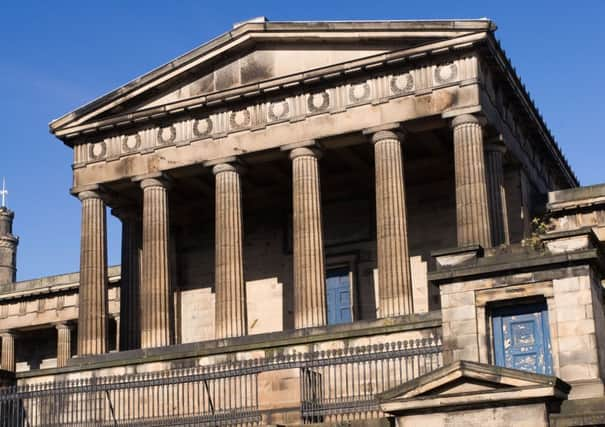Calls to protect Edinburgh world heritage site


Robust rules need to be drawn up to offer greater protection for the city’s historic landscape, according to an expert group which found “considerable” public concern over high-profile schemes.
Inspectors from a body which advises world heritage site guardians Unesco spent several days in the city assessing the impact of major schemes planned for the Caltongate area, the former Royal High School on Calton Hill and the site of the St James shopping centre.
Advertisement
Hide AdAdvertisement
Hide AdThey have now told the Scottish Government, heritage bodies and the city council to join forces to ensure new developments “do not threaten the significance and value” of the Old and New Towns, which won world heritage status in 1995.
The handling of all three developments has attracted huge controversy amid fears that classic views of the city will be ruined by the scale of the new buildings which are envisaged.
The UK committee of the International Council on Monuments and Sites said there was increasing evidence that developments of “inadequate quality” were coming forward in the city.
The hard-hitting study calls for a new blueprint safeguarding the world heritage site to ensure greater protection for the “truly remarkable urban landscape in Edinburgh.”
Advertisement
Hide AdAdvertisement
Hide AdThe ICOMOS report has been published just weeks before councillors are due to consider plans to turn the old Royal High School into a luxury hotel.
More than 2000 objections have been lodged against the proposed Rosewood hotel, which would involved creating six-storey extensions on either side of the A-listed building.
Key recommendations in the ICOMOS report include ensuring that the “coherence and marketing” of existing buildings and the city’s landscape are “respected” by major new developments.
The body has suggested new rules are drawn up to avoid the “danger” of tourism developments displacing existing communities, identify suitable sites for large-scale hotel developments and ensure blueprints for sensitive sites are “truly objective and prepared independently of the developer.”
Advertisement
Hide AdAdvertisement
Hide AdThe ICOMOS report also calls for the creation of a taskforce of heritage groups in the city to “maximise the potential of the knowledgeable conservation community in Edinburgh.”
The study was drawn up after the ICOMOS panel looked at the potential impact of new developments planned in the city centre over the next 10 years, including those that had already gone through the planning system.
The developers behind the Caltongate scheme, now rebranded as New Waverley after the site was bought up by a South African real estate consortium, were criticised for failing to respect the “mythology” of the Old Town and the significance of historic buildings, saying that simply preserving their facades was “totally inappropriate” for a world heritage site. It has called for lessons to be learned to avoid a repeat of the controversy over the site and scale of the hotel proposed for the St James quarter scheme, which has been compared to a giant walnut whip.
James Simpson, vice-president of ICOMOS UK, said: “Few developments have achieved the sort of standard appropriate to a city of such global distinction.
Advertisement
Hide AdAdvertisement
Hide Ad“We have become particularly concerned about the impact of cumulative changes affecting the character of Old Town on the residential community there.
“These will increasingly affect the outstanding universal value of the world heritage site and may ultimately make the place less authentic and less attractive, not only to those who live there, but also to those visitors for whom authenticity and the particular qualities of the world heritage site are the principal reasons for coming.”
Ian Perry, convenor of the city council’s planning committee, said: “We welcome the points made in this report, which both praises the distinctiveness of the world heritage site and makes useful recommendations for best maintaining and protecting Edinburgh’s historic urban landscape.
“Our Unesco world heritage site status is something we take very seriously, demonstrated by our intention to regularly review its management plan, working closely with Edinburgh World Heritage, Historic Environment Scotland and other agencies to ensure it is adhered to.
Advertisement
Hide AdAdvertisement
Hide Ad“As a major, European capital it is inevitable that new developments are attracted to the city centre, and this is central to our reputation as a thriving, progressive city.
“However, we are committed to managing this process very carefully, striking a fine balance between economic development and the maintenance of our historic environment.”
The Icomos report said that despite evidence of the “potentially negative impacts of new developments,” there had been “exemplary” work carried out by conservation bodies in the city.
Adam Wilkinson, director of the Edinburgh World Heritage trust, said: “We welcome the recent visit and the recognition of the great deal of work that has gone into conserving the city over the last 40 years.
Advertisement
Hide AdAdvertisement
Hide Ad“They have made a number of helpful suggestions as to how we can strengthen the management of the world heritage site.
“We look forward working with colleagues in the city council, at Historic Environment Scotland and in the wider community on how to bring these ideas to reality.”